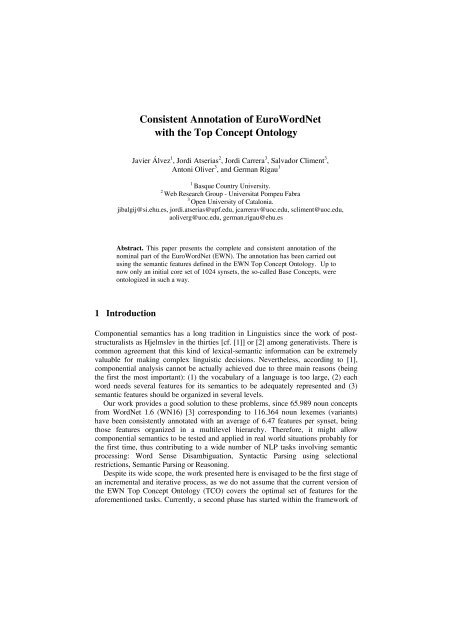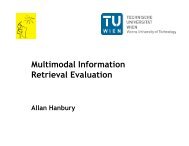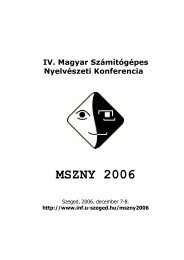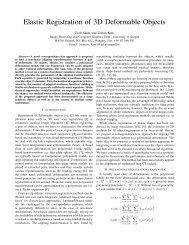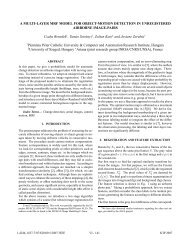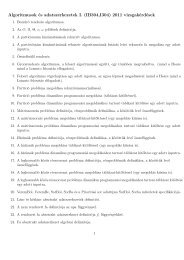- Page 1 and 2: A. Tanács, D. Csendes, V. Vincze,
- Page 3 and 4: Preface We are very pleased to hold
- Page 5 and 6: Table of Contents Papers Consistent
- Page 7 and 8: vii Methods and Results of the Hung
- Page 9: Papers
- Page 13 and 14: Consistent Annotation of EuroWordNe
- Page 15 and 16: Consistent Annotation of EuroWordNe
- Page 17 and 18: Consistent Annotation of EuroWordNe
- Page 19 and 20: Consistent Annotation of EuroWordNe
- Page 21 and 22: Consistent Annotation of EuroWordNe
- Page 23 and 24: Consistent Annotation of EuroWordNe
- Page 25 and 26: Consistent Annotation of EuroWordNe
- Page 27 and 28: Consistent Annotation of EuroWordNe
- Page 29 and 30: SemanticNet: a WordNet-based Tool f
- Page 31 and 32: SemanticNet: a WordNet-based Tool f
- Page 33 and 34: SemanticNet: a WordNet-based Tool f
- Page 35 and 36: SemanticNet: a WordNet-based Tool f
- Page 37 and 38: SemanticNet: a WordNet-based Tool f
- Page 39 and 40: SemanticNet: a WordNet-based Tool f
- Page 41 and 42: SemanticNet: a WordNet-based Tool f
- Page 43 and 44: Verification of Valency Frame Struc
- Page 45 and 46: Verification of Valency Frame Struc
- Page 47 and 48: Verification of Valency Frame Struc
- Page 49 and 50: Verification of Valency Frame Struc
- Page 51 and 52: Verification of Valency Frame Struc
- Page 53 and 54: Some Issues in the Construction of
- Page 55 and 56: 1. Hyponymy N->N hasHyponym ~ HAS_H
- Page 57 and 58: Some Issues in the Construction of
- Page 59 and 60: Some Issues in the Construction of
- Page 61 and 62:
Some Issues in the Construction of
- Page 63 and 64:
Some Issues in the Construction of
- Page 65 and 66:
A Comparison of Feature Norms and W
- Page 67 and 68:
A Comparison of Feature Norms and W
- Page 69 and 70:
A Comparison of Feature Norms and W
- Page 71 and 72:
A Comparison of Feature Norms and W
- Page 73 and 74:
A Comparison of Feature Norms and W
- Page 75 and 76:
A Comparison of Feature Norms and W
- Page 77 and 78:
A Comparison of Feature Norms and W
- Page 79 and 80:
A Comparison of Feature Norms and W
- Page 81 and 82:
A Comparison of Feature Norms and W
- Page 83 and 84:
Enhancing WordNets with Morphologic
- Page 85 and 86:
Enhancing WordNets with Morphologic
- Page 87 and 88:
Enhancing WordNets with Morphologic
- Page 89 and 90:
Enhancing WordNets with Morphologic
- Page 91 and 92:
Enhancing WordNets with Morphologic
- Page 93 and 94:
Enhancing WordNets with Morphologic
- Page 95 and 96:
Enhancing WordNets with Morphologic
- Page 97 and 98:
Enhancing WordNets with Morphologic
- Page 99 and 100:
On the Categorization of Cause and
- Page 101 and 102:
On the Categorization of Cause and
- Page 103 and 104:
On the Categorization of Cause and
- Page 105 and 106:
On the Categorization of Cause and
- Page 107 and 108:
On the Categorization of Cause and
- Page 109 and 110:
Evaluation of Synset Assignment to
- Page 111 and 112:
Evaluation of Synset Assignment to
- Page 113 and 114:
Evaluation of Synset Assignment to
- Page 115 and 116:
Evaluation of Synset Assignment to
- Page 117 and 118:
Evaluation of Synset Assignment to
- Page 119 and 120:
Using and Extending WordNet to Supp
- Page 121 and 122:
Using and Extending WordNet to Supp
- Page 123 and 124:
Using and Extending WordNet to Supp
- Page 125 and 126:
Using and Extending WordNet to Supp
- Page 127 and 128:
Using and Extending WordNet to Supp
- Page 129 and 130:
An Evaluation Procedure for Word Ne
- Page 131 and 132:
An Evaluation Procedure for Word Ne
- Page 133 and 134:
An Evaluation Procedure for Word Ne
- Page 135 and 136:
An Evaluation Procedure for Word Ne
- Page 137 and 138:
An Evaluation Procedure for Word Ne
- Page 139 and 140:
An Evaluation Procedure for Word Ne
- Page 141 and 142:
An Evaluation Procedure for Word Ne
- Page 143 and 144:
An Evaluation Procedure for Word Ne
- Page 145 and 146:
An Evaluation Procedure for Word Ne
- Page 147 and 148:
An Evaluation Procedure for Word Ne
- Page 149 and 150:
An Evaluation Procedure for Word Ne
- Page 151 and 152:
An Evaluation Procedure for Word Ne
- Page 153 and 154:
An Evaluation Procedure for Word Ne
- Page 155 and 156:
On the Utility of Automatically Gen
- Page 157 and 158:
On the Utility of Automatically Gen
- Page 159 and 160:
On the Utility of Automatically Gen
- Page 161 and 162:
On the Utility of Automatically Gen
- Page 163 and 164:
On the Utility of Automatically Gen
- Page 165 and 166:
On the Utility of Automatically Gen
- Page 167 and 168:
On the Utility of Automatically Gen
- Page 169 and 170:
On the Utility of Automatically Gen
- Page 171 and 172:
Words and Concepts in the Construct
- Page 173 and 174:
Words and Concepts in the Construct
- Page 175 and 176:
Words and Concepts in the Construct
- Page 177 and 178:
Words and Concepts in the Construct
- Page 179 and 180:
Words and Concepts in the Construct
- Page 181 and 182:
Words and Concepts in the Construct
- Page 183 and 184:
Words and Concepts in the Construct
- Page 185 and 186:
Words and Concepts in the Construct
- Page 187 and 188:
Exploring and Navigating: Tools for
- Page 189 and 190:
Exploring and Navigating: Tools for
- Page 191 and 192:
Exploring and Navigating: Tools for
- Page 193 and 194:
Using Multilingual Resources for Bu
- Page 195 and 196:
Using Multilingual Resources for Bu
- Page 197 and 198:
Using Multilingual Resources for Bu
- Page 199 and 200:
Using Multilingual Resources for Bu
- Page 201 and 202:
Using Multilingual Resources for Bu
- Page 203 and 204:
The Global WordNet Grid Software De
- Page 205 and 206:
The Global WordNet Grid Software De
- Page 207 and 208:
The Global WordNet Grid Software De
- Page 209 and 210:
The Development of a Complex-Struct
- Page 211 and 212:
The Development of a Complex-Struct
- Page 213 and 214:
The Development of a Complex-Struct
- Page 215 and 216:
The Development of a Complex-Struct
- Page 217 and 218:
WordNet-anchored Comparison of Chin
- Page 219 and 220:
WordNet-anchored Comparison of Chin
- Page 221 and 222:
WordNet-anchored Comparison of Chin
- Page 223 and 224:
WordNet-anchored Comparison of Chin
- Page 225 and 226:
WordNet-anchored Comparison of Chin
- Page 227 and 228:
WordNet-anchored Comparison of Chin
- Page 229 and 230:
Paranymy: Enriching Ontological Kno
- Page 231 and 232:
Paranymy: Enriching Ontological Kno
- Page 233 and 234:
Paranymy: Enriching Ontological Kno
- Page 235 and 236:
Paranymy: Enriching Ontological Kno
- Page 237 and 238:
Proposing Methods of Improving Word
- Page 239 and 240:
Proposing Methods of Improving Word
- Page 241 and 242:
Proposing Methods of Improving Word
- Page 243 and 244:
Proposing Methods of Improving Word
- Page 245 and 246:
Proposing Methods of Improving Word
- Page 247 and 248:
Morpho-semantic Relations in WordNe
- Page 249 and 250:
Morpho-semantic Relations in WordNe
- Page 251 and 252:
Morpho-semantic Relations in WordNe
- Page 253 and 254:
Morpho-semantic Relations in WordNe
- Page 255 and 256:
Morpho-semantic Relations in WordNe
- Page 257 and 258:
Morpho-semantic Relations in WordNe
- Page 259 and 260:
Morpho-semantic Relations in WordNe
- Page 261 and 262:
Morpho-semantic Relations in WordNe
- Page 263 and 264:
Language Independent and Language D
- Page 265 and 266:
Language Independent and Language D
- Page 267 and 268:
Language Independent and Language D
- Page 269 and 270:
Language Independent and Language D
- Page 271 and 272:
Language Independent and Language D
- Page 273 and 274:
Language Independent and Language D
- Page 275 and 276:
Language Independent and Language D
- Page 277 and 278:
Introducing the African Languages W
- Page 279 and 280:
Introducing the African Languages W
- Page 281 and 282:
Introducing the African Languages W
- Page 283 and 284:
Introducing the African Languages W
- Page 285 and 286:
Introducing the African Languages W
- Page 287 and 288:
Introducing the African Languages W
- Page 289 and 290:
Towards an Integrated OWL Model for
- Page 291 and 292:
Towards an Integrated OWL Model for
- Page 293 and 294:
Towards an Integrated OWL Model for
- Page 295 and 296:
Towards an Integrated OWL Model for
- Page 297 and 298:
Towards an Integrated OWL Model for
- Page 299 and 300:
Towards an Integrated OWL Model for
- Page 301 and 302:
Towards an Integrated OWL Model for
- Page 303 and 304:
Towards an Integrated OWL Model for
- Page 305 and 306:
The Possible Effects of Persian Lig
- Page 307 and 308:
The Possible Effects of Persian Lig
- Page 309 and 310:
The Possible Effects of Persian Lig
- Page 311 and 312:
The Possible Effects of Persian Lig
- Page 313 and 314:
Towards a Morphodynamic WordNet of
- Page 315 and 316:
Towards a Morphodynamic WordNet of
- Page 317 and 318:
Towards a Morphodynamic WordNet of
- Page 319 and 320:
Methods and Results of the Hungaria
- Page 321 and 322:
Methods and Results of the Hungaria
- Page 323 and 324:
Methods and Results of the Hungaria
- Page 325 and 326:
Methods and Results of the Hungaria
- Page 327 and 328:
Methods and Results of the Hungaria
- Page 329 and 330:
Synset Based Multilingual Dictionar
- Page 331 and 332:
Synset Based Multilingual Dictionar
- Page 333 and 334:
Synset Based Multilingual Dictionar
- Page 335 and 336:
Synset Based Multilingual Dictionar
- Page 337 and 338:
Synset Based Multilingual Dictionar
- Page 339 and 340:
Synset Based Multilingual Dictionar
- Page 341 and 342:
Synset Based Multilingual Dictionar
- Page 343 and 344:
Estonian WordNet: Nowadays 335 2 Th
- Page 345 and 346:
Estonian WordNet: Nowadays 337 4 Ad
- Page 347 and 348:
Event Hierarchies in DanNet Bolette
- Page 349 and 350:
Event Hierarchies in DanNet 341 2 D
- Page 351 and 352:
Event Hierarchies in DanNet 343 •
- Page 353 and 354:
Event Hierarchies in DanNet 345 ver
- Page 355 and 356:
Event Hierarchies in DanNet 347 of
- Page 357 and 358:
Building Croatian WordNet Ida Raffa
- Page 359 and 360:
Building Croatian WordNet 351 Table
- Page 361 and 362:
Building Croatian WordNet 353 taggi
- Page 363 and 364:
Building Croatian WordNet 355 divis
- Page 365 and 366:
Building Croatian WordNet 357 For e
- Page 367 and 368:
Building Croatian WordNet 359 13.
- Page 369 and 370:
Towards Automatic Evaluation of Wor
- Page 371 and 372:
Towards Automatic Evaluation of Wor
- Page 373 and 374:
Towards Automatic Evaluation of Wor
- Page 375 and 376:
Towards Automatic Evaluation of Wor
- Page 377 and 378:
Towards Automatic Evaluation of Wor
- Page 379 and 380:
Towards Automatic Evaluation of Wor
- Page 381 and 382:
Towards Automatic Evaluation of Wor
- Page 383 and 384:
Lexical Enrichment of a Human Anato
- Page 385 and 386:
Lexical Enrichment of a Human Anato
- Page 387 and 388:
Lexical Enrichment of a Human Anato
- Page 389 and 390:
Lexical Enrichment of a Human Anato
- Page 391 and 392:
Lexical Enrichment of a Human Anato
- Page 393 and 394:
Lexical Enrichment of a Human Anato
- Page 395 and 396:
Arabic WordNet: Current State and F
- Page 397 and 398:
Arabic WordNet: Current State and F
- Page 399 and 400:
Arabic WordNet: Current State and F
- Page 401 and 402:
Arabic WordNet: Current State and F
- Page 403 and 404:
Arabic WordNet: Current State and F
- Page 405 and 406:
Arabic WordNet: Current State and F
- Page 407 and 408:
Arabic WordNet: Current State and F
- Page 409 and 410:
Arabic WordNet: Current State and F
- Page 411 and 412:
Arabic WordNet: Current State and F
- Page 413 and 414:
Arabic WordNet: Current State and F
- Page 415 and 416:
Building a WordNet for Persian Verb
- Page 417 and 418:
Building a WordNet for Persian Verb
- Page 419 and 420:
Building a WordNet for Persian Verb
- Page 421 and 422:
Developing FarsNet: A Lexical Ontol
- Page 423 and 424:
Developing FarsNet: A Lexical Ontol
- Page 425 and 426:
Developing FarsNet: A Lexical Ontol
- Page 427 and 428:
KUI: Self-organizing Multi-lingual
- Page 429 and 430:
KUI: Self-organizing Multi-lingual
- Page 431 and 432:
KUI: Self-organizing Multi-lingual
- Page 433 and 434:
KUI: Self-organizing Multi-lingual
- Page 435 and 436:
KUI: Self-organizing Multi-lingual
- Page 437 and 438:
Extraction of Selectional Preferenc
- Page 439 and 440:
Extraction of Selectional Preferenc
- Page 441 and 442:
Extraction of Selectional Preferenc
- Page 443 and 444:
Extraction of Selectional Preferenc
- Page 445 and 446:
Extraction of Selectional Preferenc
- Page 447 and 448:
Extraction of Selectional Preferenc
- Page 449 and 450:
Romanian WordNet: Current State, Ne
- Page 451 and 452:
Romanian WordNet: Current State, Ne
- Page 453 and 454:
Romanian WordNet: Current State, Ne
- Page 455 and 456:
Romanian WordNet: Current State, Ne
- Page 457 and 458:
Romanian WordNet: Current State, Ne
- Page 459 and 460:
Romanian WordNet: Current State, Ne
- Page 461 and 462:
Enriching WordNet with Folk Knowled
- Page 463 and 464:
Enriching WordNet with Folk Knowled
- Page 465 and 466:
Enriching WordNet with Folk Knowled
- Page 467 and 468:
Enriching WordNet with Folk Knowled
- Page 469 and 470:
Enriching WordNet with Folk Knowled
- Page 471 and 472:
Comparing WordNet Relations to Lexi
- Page 473 and 474:
Comparing WordNet Relations to Lexi
- Page 475 and 476:
Comparing WordNet Relations to Lexi
- Page 477 and 478:
Comparing WordNet Relations to Lexi
- Page 479 and 480:
Comparing WordNet Relations to Lexi
- Page 481 and 482:
Comparing WordNet Relations to Lexi
- Page 483 and 484:
KYOTO: A System for Mining, Structu
- Page 485 and 486:
KYOTO: A System for Mining, Structu
- Page 487 and 488:
KYOTO: A System for Mining, Structu
- Page 489 and 490:
KYOTO: A System for Mining, Structu
- Page 491 and 492:
KYOTO: A System for Mining, Structu
- Page 493 and 494:
The Cornetto Database: Architecture
- Page 495 and 496:
The Cornetto Database: Architecture
- Page 497 and 498:
The Cornetto Database: Architecture
- Page 499 and 500:
The Cornetto Database: Architecture
- Page 501 and 502:
The Cornetto Database: Architecture
- Page 503 and 504:
The Cornetto Database: Architecture
- Page 505 and 506:
The Cornetto Database: Architecture
- Page 507 and 508:
The Cornetto Database: Architecture
- Page 509 and 510:
The Cornetto Database: Architecture
- Page 511 and 512:
The Cornetto Database: Architecture
- Page 513 and 514:
The Cornetto Database: Architecture
- Page 515 and 516:
CWN-Viz : Semantic Relation Visuali
- Page 517 and 518:
CWN-Viz : Semantic Relation Visuali
- Page 519 and 520:
CWN-Viz : Semantic Relation Visuali
- Page 521 and 522:
CWN-Viz : Semantic Relation Visuali
- Page 523 and 524:
CWN-Viz : Semantic Relation Visuali
- Page 525 and 526:
CWN-Viz : Semantic Relation Visuali
- Page 527 and 528:
CWN-Viz : Semantic Relation Visuali
- Page 529 and 530:
Using WordNet in Extracting the Fin
- Page 531 and 532:
Using WordNet in Extracting the Fin
- Page 533 and 534:
Using WordNet in Extracting the Fin
- Page 535 and 536:
Using WordNet in Extracting the Fin
- Page 537 and 538:
Using WordNet in Extracting the Fin
- Page 539 and 540:
Towards the Construction of a Compr
- Page 541 and 542:
Towards the Construction of a Compr
- Page 543 and 544:
Towards the Construction of a Compr
- Page 545 and 546:
Towards the Construction of a Compr
- Page 547 and 548:
Towards the Construction of a Compr
- Page 549 and 550:
Towards the Construction of a Compr
- Page 551 and 552:
Towards the Construction of a Compr
- Page 553 and 554:
Author List Agić, Ž. 349 Agirre,


